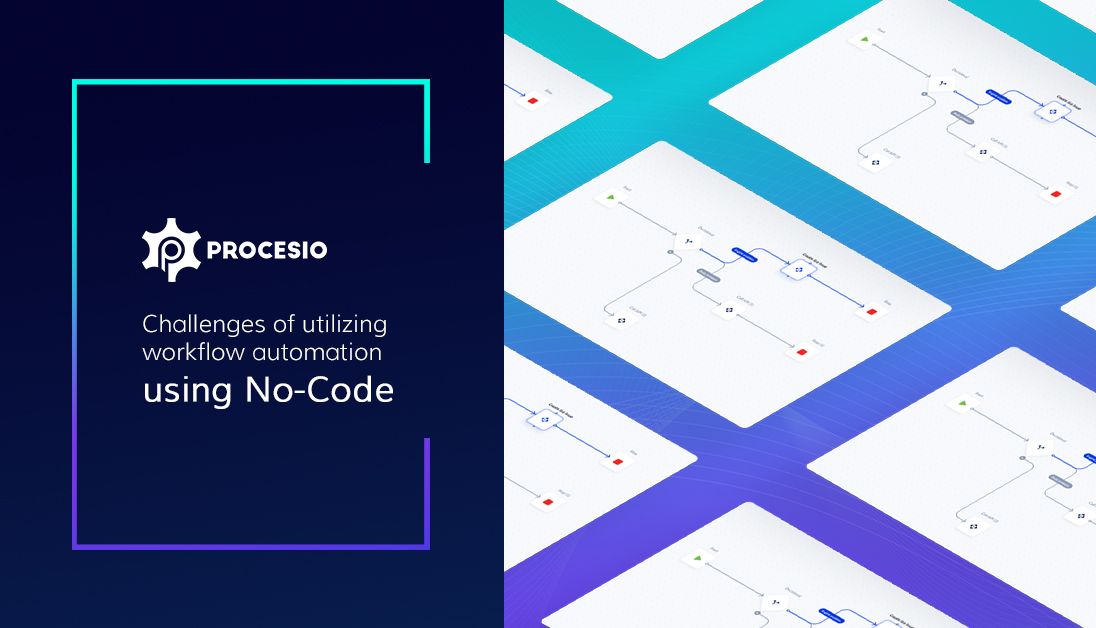With the global climate imposing the need for business agility and flexibility, some companies struggle with process optimization. Seeing the increase in demand for productivity and efficiency, IT solutions providers encounter a tough challenge: to quickly innovate and meet these expectations while following the ever-changing canvas of new best practices and cutting-edge tools. Most technologies aim to break the boundaries of task exclusivity, allowing more customization and automation in one single platform. One such technology is a no-code process automation platform.
In the past, business process and workflow automation used to be a complicated endeavour, especially for software developers and technical specialists. For starters, the time frame to automate a workflow could range between a few months to a few years. That would be a perfect scenario where everything went smoothly. The second problem was the overall cost. Can you imagine what budgets you had to have to optimize an automation process that would take months or years to produce?
Although the no-code technology reduces IT strain, decreases costs and increases productivity, it comes with its own set of challenges. This article will give you a more detailed explanation of those challenges and how to overcome them if they arise.
Integration
One of the main challenges to workflow automation using no-code is integration. While small companies can use dozens of productivity tools on a daily basis, large enterprises can use thousands. Considering these numbers, it’s hard if not impossible to integrate different services due to the inherent limitations of no-code platforms, or if a business operates in a very specialised niche. Additionally, highly niched industries often lack the connectors that are necessary to integrate or run smooth processes.
Despite the numerous integration challenges, there are ways to overcome them. A such solution is PROCESIO’s PaaS. It allows this versatility through a native call API, and makes it possible to customize the integrations according to the environment of any niched business.
Vendor Lock-In
When deciding to automate processes rather than utilizing dozens of different and separate platforms, companies may limit themselves to a set of functionalities. Apart from investing time and money to migrate all workflows into an automated process, a challenge that arises from investing time and money may be vendor lock-in. Despite the moderate costs of migrating to one single platform, businesses could find themselves in the situation of having to buy more licenses or adding sophisticated options.
In addition to this, no-code platforms do not provide access to the source code, but instead, they offer access to a pre-set commands that one can use to automate workflows without the ability to optimize it further. Additionally, to avoid getting stuck with the same provider for good, it’s essential to look for a solution that offers readable code and transferable workflows. With PROCESIO, this becomes a long-gone challenge as you can integrate it with any external software that exposes an API or triggers processes from other applications.
Customization
Another major challenge for workflow automation using no-code is, as the name suggests, the inability to customize business logic to suit specific business requirements. Out-of-the-box, no-code solutions can deliver as many use cases as they have been programmed to handle. However, when it comes to unique scenarios, things might get tricky. Scaling the system following a company acquisition or rolling out a complex workflow using no-code technology can prove ineffectual.
Since no-code platforms use visual interfaces instead of complex code-writing, finding the correct configuration for the business logic can be counterproductive when automating workflows. With that in mind, sometimes it’s faster and easier to write a piece of code rather than understanding a diagram that relates to a specific command. PROCESIO is a no-code platform that allows the best of all worlds. Non-technical business professionals can create their own applications using the user-friendly visual interfaces. For the more complex jobs, they can pass that job to developers who can adapt the applications to their exact requirements using custom code.
Security
Today’s security and data privacy are taken very seriously, with 59% of companies identifying it as the most significant challenge when adopting a no-code automation solution. With the lack of the platform’s internal workings, businesses need to rely on third-party security tools to run scans and audits without ever knowing what’s going on beneath the surface. The challenge for automating workflows is that ensuring security is particularly important and demanding for platforms deployed in the client’s data center or hosting sites.
Additionally, connecting no-code platforms to existing systems and data sources also presents security risks, especially when adding custom actions. As the no-code approach democratizes business application creation, unverified shot IT might pose security risks. While this enables greater agility, it also results in less control and oversight over business apps and workflows, which forces companies to set up rigorous security policies to ensure strict compliance. For cloud deployments, as a customer you depend on the availability of that Cloud. If there are any incidents with the Cloud system, you can be affected as well.
PROCESIO mitigates these security risks at any stage or scale of a project. Administrators can also define different access levels for users, for example read-only or admin access for different data, processes or workflows.
Debugging
On one hand, workflow automation using a no-code technology platform is a simple task. On the other hand, however, debugging an error when it appears is not. This is mainly because no-code uses visual diagrams to automate workflows, and the code behind is not visible in most cases. This takes up a lot of time to complete, and the purpose of automation is to ease the processes and workflows, not to overcomplicate them.
With PROCESIO, users are able to handle debug issues visually, or live, as they run a process. Additionally, they can add visual breakpoints, similar to traditional coding. How do you approach the debugging process?
Conclusion
Workflow automation using no-code technology is the future, but it comes with a tradeoff. By replacing ground-up coding with visual diagrams and components, it enhances employees' productivity and efficiency as it eliminates process bottlenecks and accelerates workflows.
As stated above, there are particular challenges to workflow automation, but where the no-code technology can be more effective and secure than the traditional manual-coded methods. Even if it eliminates the need for a programming language, no-code platforms still require skillful implementation and integration with optimized data flows.

